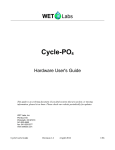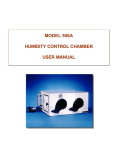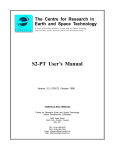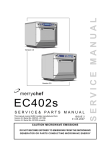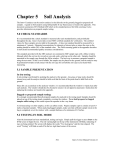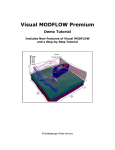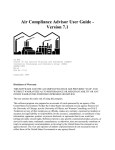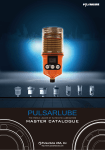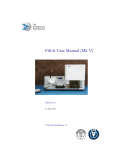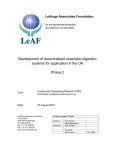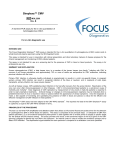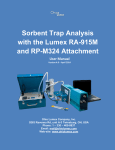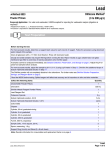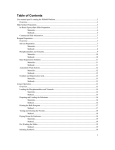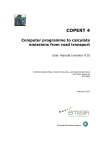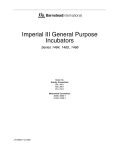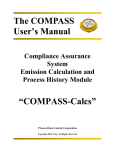Download OLM 30B Sampling System Manual
Transcript
OLM30B Sampling System Operation Manual Version 4.0 – February 2015 Ohio Lumex Company, Inc. 9263 Ravenna Rd, unit A-3 Twinsburg, OH, USA Phone: 1 – 330 – 405-0837 Email: [email protected] Web-site: www.ohiolumex.com OLM30B Sampling System Operation Manual Table of Contents Section 1: Summary of Method 30B.……………………….………………………………………3 Section 2: Setup of OLM30B Sampling Console.….…………..…………………………….…...3 2.1: Components……………………………………………………………………….……….3 2.2: Setup and Operation.….…………………………………………………………….……6 Section 3: Operation. Temperature and Flow Rate…………………...........................................9 3.1: Probe Temperature………………………..…………………..........................................9 3.2: Flow Rate...…………………………………………………..........................................10 Section 4: Initial Vacuum Check……………………………………...........................................11 Section 5: Sampling..……………………………………………………………………………….12 Section 6: Final Vacuum Check.……………………………………………….………………....13 Section 7: (ALT-091) Approval of Alternative Procedures for Determination of Moisture Content.………………………………………………………………………………..……………...13 Section 8: Equipment Tear Down…………………………………...……………………..………16 Appendix A: Speciation trap Standard Operating Procedure (SOP)..…………………………..17 Appendix B: MSDS for Drierite…………………………………………………………………...…21 Appendix C: Method 30B: Determination of total vapor phase mercury emissions from coalfired combustion sources using carbon sorbent traps………………………………………….1-1 2 OLM30B Sampling System Operation Manual Section 1: Summary of Method 30B Known volumes of flue gas are extracted from a stack or duct through paired, in-stack sorbent media traps at an appropriate flow rate as determined by the guidelines explained in Section 3. Collection of mercury on the sorbent media in the stack mitigates potential loss of mercury during transport through a probe/sample line. For each test run, paired train sampling is required to determine measurement precision and verify acceptability of the measured emissions data. A field recovery test which assesses recovery of an elemental Hg spike to determine measurement bias is also used to verify data acceptability. The sorbent traps are recovered from the sampling system and analyzed by any suitable determinative technique that can meet the performance criteria such as Zeeman spectroscopy thermal technique. Section 2: Setup of OLM30B Sampling Console 2.1: Components Figure 2.1 The OLM30B sampling system (Figure 2.1) comes with a sampling console, a pair of Drierite driers, a sampling probe, blower and connection hose (Figure 2.2 and 2.3), air lines, power lines, and a thermocouple line, pack of extra Drierite supply, scrubber wrenches. The OLM30B Sampling Console is pictured here (Figure 2.4). 3 OLM30B Sampling System Operation Manual Figure 2.2 Figure 2.3 The OLM30B console is a dual train fully functional sampling system, complete with Mass Flow Controllers (from here on out dubbed 'MFC'), vacuum pressure gauges, and a Watlow controller with thermocouple input and probe power port. Figure 2.4 The MFC's are capable of setting independent flow rates for both Train A and Train B. The flow rates are easily adjusted [See Section 3] and the total volumes are easily displayed and reset to zero. The scrubber unit is an indicator based Drierite dryer and acid gas stripping section. Drierite appears blue in color while still active, and fades to a pink color when spent. The 4 OLM30B Sampling System Operation Manual Drierite material is easily restored by heating the desiccant. To accomplish this, first remove both hose connections to the valves. Slide the canister wrench with the notch up the canister from the bottom (wrenches come with system). Place the second wrench over the lid and remove lid. Remove the cloth liner and pour out the spent desiccant. It then should be spread about in shallow pans 1-3 granules deep and heated in an oven to 450 F (232 C°) for 60 Min to achieve complete dehydration. The regenerated material should be placed in the original glass or metal container and sealed while hot to prevent scrubbing ambient moisture. The short section in the scrubber is sodium carbonate, and must be replaced every 6 months (with standard use). More information about these dryers (including the MSDS) can be found at: http://www.drierite.com/. The sampling probe is a dual action probe. It has the ability to be both heated by the Watlow Controller, and cooled by a separate blower. At the base of the probe are two independent thermocouple connectors. Figure 2.5 One is rigid and near the base of the probe. When it is connected it will output the stack gas temperature. The second is the free floating thermocouple connector which marked '1' in the above picture. This, when connected, will output the temperature inside the probe at the sorbent trap location. The probe will have two ¼ in Swagelok male connectors to connect train A and train B pneumatic lines to. In addition, on the side of the probe is a tube sticking out. This tube is 1” in diameter and is the intake cooling port which connects with the blower cooling air output via 6 feet of hose attached designed for probe cooling. On the trap end of the probe, there are two compression fittings with Teflon ferrules inside. 5 OLM30B Sampling System Operation Manual 2.2: Setup and Operation Figure 2.6 To setup the OLM30B sampling console, you will need a 9/16 open end wrench, an adjustable wrench, and an available electrical circuit (Figure 2.6). During set up, hand tighten every connection until all connections are made, then go back and tighten with a wrench when instructed to. Plug the black power cable into the side of the OLM30B console (Figure 2.7). Next plug this into a 110/220 VAC power source. Get one of the short 3 feet long airlines that have stainless steel compression fittings. Figure 2.7 Attach the stainless steel compression fitting to the sample “Trap A” port on the OLM30B console (Figure 2.8). 6 OLM30B Sampling System Operation Manual Figure 2.8 Figure 2.9 Connect the other fitting to the compression fitting at the top ¼ in connector on the Drierite dryer (Figure 2.8). Grab a second airline. Connect the connector to the bottom of the dryer and then connect the stainless steel end to the Trap A connector on the probe. Repeat these steps for train B. [“Train B” refers to the complete sampling pathway for Trap B]. Connect the long 6 feet air line from scrubbers to the probe ¼ inch connectors. Maintain color coordinated pass way. Figure 2.10 Figure 2.11 After all connections are made, it is time to tighten the connections. To both connections at the console (Trap A and Trap B) take the 9/16 inch wrench and turn them gently (Figure 2.10). 7 OLM30B Sampling System Operation Manual To tell if the connection is tight enough, grab a hold of the line and try to turn it. If the line is able to turn or move at all in the connection it is not tight. Again, if you can turn the line in the connection it is not tight enough. Do not over tight! After all air lines are connected and tight, it is time to attach the probe lines. There are two lines used here. One is a power line and the other is a thermocouple line. They are combined in a single 8 foot line. The power line plugs into the OLM30B console into the “Probe Power” port on the side. The other end connects to the power port on the end of the probe. Figure 2.12 The thermocouple is a 'k-type' thermocouple. This line is designed in a way that it cannot be connected backwards. It connects to the yellow port on the side of the OLM30B, and to probe thermocouple male connector. This is the long free cable labeled '1', not the rigid mounted connector. The rigid mounted connector outputs stack gas temperature, whereas the free mounted outputs the trap temperature. Figure 2.13 Figure 2.14 8 OLM30B Sampling System Operation Manual At the end of the probe, remove the two compression fittings to allow the sorbent traps to be placed in the probe (Figure 2.13). Be very careful not to misplace the two Teflon ferrules inside the fittings. Grab two official Ohiolumex 30B sorbent traps, and place the ferrules around them. Make sure the ferrule is facing down [the smaller outer diameter end should be facing the probe], and slide the sorbent traps into the probe. Tighten the compression fittings hand tight. Do not over tighten these fittings. Place one of the caps that came with the Ohiolumex sorbent trap over the open end of both the traps (Figure 2.14). Place a trap shield over the fittings after leak check to protect traps from direct moisture entrainment (Figures 2.15 and 2.16). Figure 2.15 Figure 2.16 Section 3: Operation. Temperature and Flow Rate 3.1: Probe Temperature Make sure the Pumps ON switch is in Volume Reset position. Turn the Power ON switch to upper position. The lights on the controllers will come up and the switch will retract back to middle position. The probe must be heated (in wet conditions after wet FDG stack scrubber) to ensure no moisture interacts with the sorbent trap. A wet trap has a negative bias and will not accurately represent the Mercury concentrations in the stack. In order to prevent moisture issues, the probe (and sorbent trap) must be heated above the vaporization point of water. The standard target temperature is 130 C° (See Figure 3.1). The Watlow controller on the OLM30B is the probe temperature control unit. It comes preprogrammed to accept an input signal from the probe thermocouple [See Section 2] and to 9 OLM30B Sampling System Operation Manual manage power requirements of the probe to maintain the set point temperature of 130 C°. To adjust the set point on the Watlow controller, use the ▲(up) and ▼(down) arrow keys. Figure 3.1 The changes will automatically take effect. The set point is the green-yellow value on the right hand side, while the red value is the live reading of the trap/probe temperature. If the flue gas temperature is above 200 C° for 30 B traps or 110 C° for speciating traps, a cooling fan must be attached. The cooling fan line will attach to the 1 in port at the end of the probe. The hose should be connected to the air in port on the blower. Make sure to keep both the heating and cooling systems running at the same time to ensure a steady probe temperature. 3.2: Flow Rate Flow rate is controlled by the MFC for each train independently. The MFC serves both as a flow rate regulator, as well as a sample Total volume display. Flow rate values are determined by minimum sample mass requirements, sample run times, flue gas moisture, and expected sample concentrations [See Section 8 of Method 30 B]. The standard flow rate for 30B sampling is 0.5 Lpm (See Figure 3.2). If higher values are used, the risk of moisture getting into the sorbent trap increases. A longer run time is a more reliable method to increase sample mass. Figure 3.2 10 OLM30B Sampling System Operation Manual Four flow rate settings are preset from the factory: SP0=0.25 Lpm, SP1=0.50 Lpm, SP2=1.00 Lpm, SP3=2.00 Lpm. To select the flow press and hold the “Disp” button on the MFC for 3 seconds and select flow using (▲) up and (▼) down arrow keys. Press ENTER twice to save the flow setting. To manually adjust flow rate, press the 'Disp' button on the MFC until this screen is present. The bottom orange number is the flow rate set point and the top green-yellow number is the flow rate. Use the (▲) up and down (▼) arrow keys to adjust the flow rate (which will blink while it is being adjusted). To save and apply these changes press the 'Ent' button. At this point, the blinking will stop, and the green-yellow numbers will match the new Flow Rate Temperature Lpm 0.5 130 C SCCM 500 266 F SCFH 1.06 set point. Total Volume: The MFC programmed from the factory to accumulate 30.0 liters of Total volume and stop pumps. Once the 30 liters volume is reached the pumps will automatically stop and the MFC valve will close to prevent any gas movement through the trap. To view volume totalizer during sampling press “DISP” button once. To change the Total volume setting press “DISP” once (back arrow key) and hold until display changes. Use up or down arrow keys until display reads “E.A.Lo”. Press “ENTER” and move flashing digit to the left by pressing back arrow key. Use (▲) up and (▼) down arrow key to change the settings to new total volume. Press “ENT” when finished. Press “DISP” to return home screen. Pump will shut off automatically when total volume is reached. Switch Volume reset to reset volume to ZERO. Note: The volume is normalized to 20 degrees C and 1 atmosphere. The Calibration Factor for MFC adjusted to 0.935 representing stack gas mixture of 6%O2, 12%CO2, and 82% N2. Please use Calibration Factor 0.955 for 10%O2, 15%CO2, and 82% N2. Please note: Once reset the total volume is not recovered. Make sure you wrote the total on chain of custody before reset. Section 4: Initial Vacuum Check The initial vacuum check is a process used to verify there are no leaks in the train. If there is a leak, the volume pulled will not accurately reflect the volume pulled through the sorbent trap. With a cap over the end of the trap, turn on the pumps. After a few minutes, the flow rate 11 OLM30B Sampling System Operation Manual displayed on the MFC should drop down to zero (Figure 4.1). Figure 4.1 Figure 4.2 Figures 4.3 If the flow does not drop down, there is a leak in the system. To find this leak, first check all of the connections. Try to turn the line inside the fitting, if it moves it is too loose. If the flow does drop down to zero, check the pressure vacuum gauge. Verify the gauge stays constant for at least 30 seconds. When this has been achieved, reset the Totalizer volume on the MFC. Remove the caps from the end of the traps slowly, allowing the probe to refill with air (Figure 4.3). If the caps are removed rapidly, the probe's vacuum pressure can dislodge the sorbent inside the trap and induce a failed trap. Section 5: Sampling Safety Warning: The probe and traps are very hot. Always wear approved heat resistant gloves as well as standard PPE when operating the OLM30B. This includes but is not limited to: safety glasses, hard-hat, steel toe boots, long sleeve shirt, and work pants. After the probe temperature has reached its set point and the volume has been reset, as in the photo above (Figure 5.1), sampling can begin. Figure 5.1 Figure 5.2 12 OLM30B Sampling System Operation Manual Select the flow setting and turn on the pumps. Quickly place the probe into the sampling port. Note, if under negative pressure [air is being pulled into the port], it is very important to prevent outside air from being sucked in. This outside air will dilute the sample gas, and negatively bias your trap results. Place a rag or a small plastic tarp like material around the port. Run times are determined by Section 8 of Method 30B. A target mass range for 30B sampling is [40-100] ng. Typical run times for stack locations are on the order of 1 hour at 0.5 Lpm. This run time can be adjusted based on expected concentrations. At the end of the run, the pumps will turn off, and pull out the probe from the port. Be careful to keep the probe level for the remainder of the process to prevent any condensed moisture from dripping back down into the trap. Record the volume, time, and temperature on the chain of custody (Figure 5.2). Reset the volume to zero. A successful final vacuum check is required to validate the trap. Section 6: Final Vacuum Check To validate a run, a final vacuum check must be performed to guarantee no leak was created during the run. Follow the same procedure as the initial vacuum check (place caps on the front of traps) (see Section 4). If the flow drops to zero and the vacuum gauge holds steady, the trap is successful. If the flow does not drop to zero, or the gauge does not hold steady, then the trap has failed and the results do not represent the flue gas' Mercury concentration. There will be a negative bias. Section 7: (ALT-091) Approval of Alternative Procedures for Determination of Moisture Content As an alternative to Method 4: Determination of Moisture Content in Stack Gases, the following method of stack gas moisture content calculation ((ALT-091) Approval of Alternative Procedures for Determination of Moisture Content) is based on stack temperature as the determinant factor and is only applicable for wet stacks. The main assumption of the method is that the stack gas is 100% saturated. In order to determine moisture content use Table 7.1 below. For more information on http://www.epa.gov/ttn/emc/approalt.html. 13 this alternative method go to: OLM30B Sampling System Operation Manual Table 7.1 Moisture Content in Stack @ 100% Saturation Temperature (deg F) Temperature (deg C) Saturated Water Vapor Pressure (inch Hg) Saturated Water Vapor Pressure (bar) Moisture Content (%) 32 33.8 35.6 37.4 39.2 41 44.6 46.4 48.2 50 51.8 53.6 55.4 57.2 59 60.8 62.6 64.4 66.2 68 69.8 71.6 73.4 75.2 77 78.8 80.6 82.4 84.2 86 87.8 89.6 91.4 93.2 0 1 2 3 4 5 7 8 9 10 11 12 13 14 15 16 17 18 19 20 21 22 23 24 25 26 27 28 29 30 31 32 33 34 4.581 4.924 5.291 5.681 6.097 6.539 7.51 8.041 8.606 9.204 9.839 10.512 11.226 11.982 12.781 13.628 14.524 15.47 16.47 17.53 18.64 19.82 21.06 22.37 23.75 25.2 26.37 28.34 30.03 31.81 33.69 35.65 37.72 39.89 0.00602763 0.00647895 0.00696184 0.00747500 0.00802237 0.00860395 0.00988158 0.01058026 0.01132368 0.01211053 0.01294605 0.01383158 0.01477105 0.01576579 0.01681711 0.01793158 0.01911053 0.02035526 0.02167105 0.02306579 0.02452632 0.02607895 0.02771053 0.02943421 0.03125000 0.03315789 0.03469737 0.03728947 0.03951316 0.04185526 0.04432895 0.04690789 0.04963158 0.05248684 0.38% 0.41% 0.44% 0.47% 0.50% 0.54% 0.62% 0.67% 0.71% 0.76% 0.82% 0.87% 0.93% 1.00% 1.06% 1.14% 1.21% 1.29% 1.38% 1.47% 1.56% 1.67% 1.77% 1.89% 2.01% 2.13% 2.24% 2.41% 2.56% 2.72% 2.89% 3.06% 3.25% 3.45% 14 OLM30B Sampling System Operation Manual 95 96.8 98.6 100.4 102.2 104 105.8 107.6 109.4 111.2 113 114.8 116.6 118.4 120.2 122 125.6 129.2 132.8 136.4 140 143.6 147.2 150.8 154.4 158 161.6 165.2 168.8 172.4 176 179.6 183.2 186.8 190.4 194 197.6 201.2 204.8 208.4 35 36 37 38 39 40 41 42 43 44 45 46 47 48 49 50 52 54 56 58 60 62 64 66 68 70 72 74 76 78 80 82 84 86 88 90 92 94 96 98 42.17 44.55 47.06 49.69 52.44 55.32 58.33 61.49 64.8 68.25 71.87 75.65 79.6 83.72 88.03 92.52 102.11 112.53 123.83 136.11 149.39 163.8 179.3 196.1 214.2 233.7 254.7 277.2 301.4 327.4 355.2 385 416.9 450.8 487.2 525.9 567.1 611 657.8 707.3 15 0.05548684 0.05861842 0.06192105 0.06538158 0.06900000 0.07278947 0.07675000 0.08090789 0.08526316 0.08980263 0.09456579 0.09953947 0.10473684 0.11015789 0.11582895 0.12173684 0.13435526 0.14806579 0.16293421 0.17909211 0.19656579 0.21552632 0.23592105 0.25802632 0.28184211 0.30750000 0.33513158 0.36473684 0.39657895 0.43078947 0.46736842 0.50657895 0.54855263 0.59315789 0.64105263 0.69197368 0.74618421 0.80394737 0.86552632 0.93065789 3.65% 3.87% 4.11% 4.35% 4.61% 4.88% 5.17% 5.48% 5.80% 6.14% 6.50% 6.88% 7.28% 7.70% 8.15% 8.62% 9.65% 10.81% 12.11% 13.57% 15.22% 17.09% 19.21% 21.63% 24.41% 27.62% 31.35% 35.71% 40.88% 47.07% 54.58% 63.86% 75.58% 90.68% 111.08% 139.73% 182.86% 255.06% 400.34% 834.80% OLM30B Sampling System Operation Manual Section 8: Equipment Tear Down While wearing heat resistant gloves, first remove the traps from the probe by loosening the compression fittings on the end and sliding them out. The ferrule will likely come with it, just slide it off the trap and place back in the fitting and reattach to the probe. Disconnect the airlines, thermocouple line, and power line to the probe. Disconnect the thermocouple, power lines, and air lines from the OLM30B console. Allow 10-20 minutes of cooling time before handling the probe with bare hands. 16 OLM30B Sampling System Operation Manual APPENDIX A SPECIATION TRAP STANDARD OPERATING PROCEDURE (SOP) Subject Mercury Emissions Monitoring Program Speciation Sorbent Trap Sampling and Analysis Brief Prepared by Analytical Laboratory of Ohio Lumex Company Revised on January 15th, 2013 17 OLM30B Sampling System Operation Manual 1 SPECIATION TRAP SAMPLING PROCEDURE RECOMMENDATIONS S0 = Acid Gas Scrubber (AGS) S1 = Oxidized Mercury Analytical Bed (KCl) S2 = Oxidized Mercury Breakthrough Bed (KCl) S3 = Elemental Mercury Analytical Bed (Carbon) S4 = Elemental Mercury Analytical Bed (Carbon) Figure 1. Illustration of a Speciation Trap There are two types of sampling locations and each has its own set of procedures and recommendations to follow. Please use the following procedures when sampling and analyzing Speciation traps. FGD INLET/AFTER ESP, SCR, NSCR, or “DRY” STACK LOCATION: Traps should be sampled directly in the stack and not externally. TEMPERATURE: The recommended trap temperature range for Speciation traps is between 220°F and 300°F. A cooling probe is only needed if you experience breakthroughs after 30 minutes of sampling (high SO2 >1000ppm and/or SO3 > 30ppm concentration) or if the flue gas temperature exceeds 350oF. FLOW RATE: The recommended flow rate for Speciation traps is between 200cc/min and 250cc/min. SAMPLE VOLUME: The recommended sample volume is close to 20L (depending on the source concentration.) This will provide sufficient mercury capture that can be easily distinguished from background levels and make analysis easy to perform. STARTING PUMPS: The standard leak check procedure should be done and documented. The sampling pumps should be started before the probe is inserted into the duct. This is extremely important if there is positive pressure at the sample location or if you are using a mass flow controller to control the flow as it will prevent initial direct particulate entrainment on the front plug. SHROUD: A shroud of 6 to 12 inches in length MUST be used to prevent particulate from entering the trap during the test run. Please use thin aluminum (available as roofing material in Home Depot) and a clamp to hold it to the end of the probe. WET STACK LOCATION (AFTER FGD): Traps should be sampled directly in the stack and not externally. TEMPERATURE: The 4-8 inches before the first section on the trap must be heated inside of the probe to at least 230oF and must not exceed 300oF. This will ensure that any moisture remains in the vapor phase as it passes through the trap. It is also important to make sure the probe is fully heated before it 18 OLM30B Sampling System Operation Manual is inserted into the stack. FLOW RATE: The recommended flow rate is between 200cc/min and 250cc/min. SAMPLE VOLUME: The recommended sample volume is approximately 20L (depending on the source concentration.) This will provide sufficient mercury capture that can be easily distinguished from background levels and make analysis easy to perform. STARTING PUMPS: The pump should be started before the probe is inserted into the stack. SHROUD: A shroud of 6 to 12 inches in length MUST be used to prevent direct moisture entrainment during the test run. ADDITIONAL NOTES: For inlet or dry stack locations, the shroud used must be made from a material that will not be affected by the high temperatures of the flue gas (as described above). The shroud used in a wet stack location can be made out of plastic tube or metal. The distribution of oxidized mercury over the AGS and KCl sections is dependent upon many factors, but it is important to know that the plugs will capture oxidized mercury. The bond that is created between these sections and the oxidized mercury is a very weak physical bond and too much temperature or flow will cause these bonds to fail and result in breakthrough. For both locations the front plug must have minimum amount of particulate or discoloration from white color. Please note: Large amount of particulate or moisture on the front plug will skew the Total and speciation ratio and make the run invalid. We have found that the aforementioned sampling procedures will yield the most consistent and reproducible results. 2 SPECIATION TRAP ANALYSIS PROCEDURE RECOMMENDATIONS S0 = Acid Gas Scrubber (AGS) S1 = Oxidized Mercury Analytical Bed (KCl) S2 = Oxidized Mercury Breakthrough Bed (KCl) S3 = Elemental Mercury Analytical Bed (Carbon) S4 = Elemental Mercury Analytical Bed (Carbon) Figure 1. Illustration of a Speciation Trap 19 OLM30B Sampling System Operation Manual For full analytical procedure, please refer to the Speciation Traps Analytical SOP. 1. Clean the furnace and analyzer windows before heating up the furnace. Calibrate analyzer as per method 30B using carbon as calibration substrate. Change temperature set point on Watlow controller (use up/down arrow keys) to 590°C. The furnace must look almost dark if looking inside through the ladle entry hole. Only one calibration curve is required for the analysis of AGS, KCl, and carbon. Cover all sections with soda except for the AGS section. Soda must be pressed using a sheet of Aluminum Foil. Never place KCL on top of carbon. Use upgraded pump station and set flow rate to 0.5 Lpm. Use low level calibration from 2ng to 20 ng and use averaged calibration coefficient in calculations. 2. Please “burn off” ladles before you proceed with analysis. After heating in the furnace, let the ladle cool before cleaning off the residue. Remove sticking residue by gently scraping the ladle or washing it in water. Melting or fusing of the KCL with soda indicates overheating so you must drop the temperature on the controller 10 or 20 degrees. Wash ladle with water at the end of the day of testing. Use ceramic ladles. 3. Average analysis time is 180-220 seconds. Wait for KCL peak to come back to baseline (it will “tail”!). Extended analysis time in the furnace (over 300 sec) indicates that the temperature is too low. Manually integrate the peaks to ensure only the captured sampled mercury is accounted for (not the baseline noise). 4. Do not pull the glass wool through the trap (ash bonded mercury will bias the results.) Cut the traps with a dremel fitted with a diamond wheel blade right before the front plug. 5. Wrap the plug wool in aluminum foil before ladle goes in the furnace and wear rubber gloves to ensure there is no additional mercury transferred to the plugs. Test the foil for mercury adsorbed from air and discard if positive. Test the carbon used in calibration. Do not leave carbon open to lab air for long time. 6. You may combine first and second wool plugs (P0, P1) to save on analysis time. You may analyze section 0 (acid gas scrubber) and section 1 (1st bed of KCL) together. P2 and section 2 must be analyzed separately to determine if breakthrough is present. 7. The remaining carbon sections are to be analyzed just like a 30B sorbent trap. 8. Oxidized mercury is equal to the loading on section 0 (acid gas scrubber), section 1 (KCL), and section 2 (KCL breakthrough) as well as (P0, P1, P2) combined. If breakthrough is experienced, sampling conditions must be altered to prevent this from happening again. Elemental mercury is equal to the loading on section 3 and section 4 as well as (P3, P4, P5) combined. 9. Try not to spill soda in the oven. Clean oven (when still hot) at the end of the day with vacuum cleaner nozzle approaching from the ladle intake port. Disconnect silicone lines (before filter) to provide unrestricted flow back through the Furnace. Connect lines back. 20 MATERIAL SAFETY DATA SHEET IDENTITY: INDICATING DRIERITE DESCRIPTION: 1/16” TO ¼” BLUE GRANULES DATE PREPARED: 11-1-2014 SECTION I MANUFACTURERS NAME: W.A. HAMMOND DRIERITE CO., LTD. ADDRESS: P.O. BOX 460, 138 DAYTON AVE., XENIA, OHIO 45385 EMERGENCY PHONE NUMBER: 937-376-2927 INFORMATION PHONE NUMBER: 937-376-2927 www.drierite.com CHEMICAL IDENTITY % CALCIUM SULFATE, >98 COBALT CHLORIDE <2 SECTION II INGREDIENTS OSHA PEL ACGIH TLV UNITS C.A.S. # TSCA # 15 10 mg//M 3 7778-18-9 A739-8876 0.05* 0.05* mg/M 3 7646-79-9 A451-6434 *(AS COBALT METAL) HAZARDOUS MATERIAL IDENTIFICATION SYSTEMS (HMIS) HEALTH FLAMMABILITY REACTIVITY PROTECTIVE EQUIPMENT 1 0 1 E SECTION III PHYSICAL/CHEMICAL CHARACTERISTICS SPECIFIC GRAVITY: (H20-1): 1.87 SOLUBILITY IN WATER: 0.25 GRAMS PER LITER MELTING POINT: 1450 C DECOMPOSES APPEARANCE: BLUE GRANULES; NO ODOR SECTION IV FIRE AND EXPLOSION HAZARD DATA FLASH POINT: NONE EXTINGUISHER MEDIA: NOT COMBUSTABLE SPECIAL FIRE FIGHTING PROCEDURES: NONE UNUSUAL FIRE AND EXPLOSION HAZARDS: NONE SECTION V REACTIVITY DATA STABILITY: STABLE INCOMPATIBLE (MATERIALS TO AVOID): STRONG ACIDS HAZARDOUS DECOMPOSITION BYPRODUCTS: SO3 @ 1450 C Cl2 @318 C HAZARDOUS POLYMERIZATION: WILL NOT OCCUR SECTION VI HEALTH HAZARD DATA EYES: PARTICLES MAY CAUSE IRRITATION SKIN: THIS MATERIAL IS NOT TOXIC. MAY DRY OR IRRITATE SKIN INHALATION: MAY CAUSE AN IRRITATION OR RESPIRATORY ORGANS OF SENSITIVE PERSONS RESULTING IN THE OBSTRUCTION OF AIR WAYS WITH SHORTNESS OF BREATH. INGESTION: MAY CAUSE VOMITING, DIARRHEA, AND SENSATION OF WARMTH. SIGNS AND SYMPTOMS OF OVER EXPOSURE: EYES, NOSE, THROAT, OR RESPIRATORY IRRITATION CARCINOGENICITY OF INGREDIENTS: MATERIAL IARC NTP OSHA ALL NOT LISTED NOT LISTED NOT LISTED COBALT CHLORIDE YES* NO NO *(COBALT & COBALT COMPOUNDS ARE CLASSIFIED AS GROUP 2B) MEDICAL CONDITIONS GENERALLY AGGRAVATED BY EXPOSURE: PRE-EXISTING UPPER RESPIRATORY AND LUNG DISEASE SUCH AS, BUT NOT LIMITED TO BRONCHITIS, EMPHYSEMA & ASTHMA EMERGENCY AND FIRST AID PROCEDURES: EYES: FLUSH WITH WATER. IF IRRITATION CONTINUES OBTAIN MEDICAL ATTENTION DUST INHALATION: REMOVE TO FRESH AIR SKIN: WASH WITH WATER INGESTION: IF PATIENT IS CONSCIOUS, INDUCE VOMITING. OBTAIN MEDICAL ATTENTION SECTION VII SPILL OR LEAKAGE PROCEDURES STEPS TO BE TAKEN IN CASE MATERIAL IS RELEASED OR SPILLED: SWEEP OR VACUUM MATERIAL INTO APPROPRIATE WASTE CONTAINER FOR DISPOSAL. AVOID DUSTING CONDITIONS WASTE DISPOSAL METHOD: THIS MATERIAL CAN BE DISPOSED OF IN ACCORDANCE WITH PROCEDURES ACCEPTABLE UNDER FEDERAL, STATE, AND LOCAL REGULATIONS. PRECAUTIONS TO BE TAKEN IN HANDLING AND STORING: KEEP CONTAINER CLOSED. STORE IN COOL DRY PLACE. AVOID GENERATING DUST. SECTION VIII CONTROL MEASURES RESPIRATORY PROTECTION: MASK NIOSH/OSHA APPROVED FOR DUST VENTILATION: TO MEET TLV REQUIREMENTS EYES: SAFETY GLASSES OR GOGGLES OTHER PROTECTIVE EQUIPMENT: GLOVES OR PROTECTIVE CLOTHING NOT USUALLY NECESSARY BUT MAY BE DESIRABLE IN SPECIFIC WORK SITUATIONS. SECTION IX REFERENCES U.S. DEPARTMENT OF LABOR - OSHA FORM APPROVED OMB NO. 1218-0072 OSHA HAZARD COMMUNICATION STANDARD-29 CFR 1910. 1200 U.S. GYPSUM CO. & SHEPARD CHEMICAL ALTHOUGH THE INFORMATION AND RECOMMENDATION SET FORTH HEREIN ARE PRESENTED IN GOOD FAITH AND BELIEVED TO BE CORRECT AS OF THE DATE HEREOF, THE W.A. HAMMOND DRIERITE CO.,LTD. MAKES NO REPRESENTATION AS TO THE COMPLETENESS OR ACCURACY THEREOF. INFORMATION IS SUPPLIED UPON THE CONDITION THAT THE PERSON RECEIVING IT WILL MAKE THEIR OWN DETERMINATION AS TO ITS SUITABILITY FOR THEIR PURPOSE PRIOR TO USE. IN NO EVENT WILL THE W.A. HAMMOND DRIERITE CO., LTD. BE RESPONSIBLE FOR DAMAGES OF ANY NATURE WHATSOEVER RESULTING FROM THE USE OF OR RELIANCE UPON INFORMATION HEREIN SUPPLIED. NO REPRESENTATIONS OR WARRANTIES, EITHER EXPRESSED OR IMPLIED, OF MERCHANTABILITY, FITNESS FOR A PARTICULAR PURPOSE OF OR ANY OTHER NATURE MADE HEREUNDER WITH RESPECT TO INFORMATION OR THE PRODUCT TO WHICH INFORMATION REFERS. METHOD 30B – DETERMINATION OF TOTAL VAPOR PHASE MERCURY EMISSIONS FROM COAL-FIRED COMBUSTION SOURCES USING CARBON SORBENT TRAPS 1.0 Scope and Application What is Method 30B? Method 30B is a procedure for measuring total vapor phase mercury (Hg) emissions from coal-fired combustion sources using sorbent trap sampling and an extractive or thermal analytical technique. This method is only intended for use only under relatively low particulate conditions (e.g., sampling after all pollution control devices). Quality assurance and quality control requirements are included to assure that you, the tester, collect data of known and acceptable quality for each testing program. This method does not completely describe all equipment, supplies, and sampling and analytical procedures you will need, but instead refers to other test methods for some of the details. Therefore, to obtain reliable results, you should also have a thorough knowledge of these additional methods which are found in Appendices A-1 and A-3 to this part: (a) Method 1—Sample and Velocity Traverses for Stationary Sources. (b) Method 4—Determination of Moisture Content in Stack Gases. (c) Method 5—Determination of Particulate Matter Emissions from Stationary Sources 1.1 Analytes. What does this method determine? This method is designed to measure the mass concentration of total vapor phase Hg in flue gas, including elemental Hg (Hgo) and oxidized forms of Hg (Hg+2), in micrograms per dry standard cubic meter 1 (µg/dscm). Analyte CAS No. Elemental Hg (Hgo) 7439-97-6 Oxidized Hg (Hg+2) ----- Analytical Range and Sensitivity Typically 0.1 µg/dscm to > 50 µg/dscm (Same) 1.2 Applicability. When is this method required? Method 30B is a reference method for relative accuracy test audits (RATAs) of vapor phase Hg CEMS and sorbent trap monitoring systems installed at coal-fired boilers and is also appropriate for Hg emissions testing at such boilers. It is intended for use only under relatively low particulate conditions (i.e., sampling after all pollution control devices); in cases where significant amounts of particle-bound Hg may be present, an isokinetic sampling method for Hg should be used. Method 30B may also be specified by New Source Performance Standards (NSPS), National Emission Standards for Hazardous Air Pollutants (NESHAP), emissions trading programs, State Implementation Plans (SIPs), and operating permits that require measurement of Hg concentrations in stationary source emissions, either to determine compliance with an applicable emission standard or limit, or to conduct RATAs of Hg CEMS and sorbent trap monitoring systems. 1.3 Data Quality Objectives (DQO). How good must my collected data be? Method 30B has been designed to provide data of high and known quality for Hg emissions testing and for RATA testing of Hg monitoring systems, including CEMS and sorbent trap monitors. In these and other applications, the principal objective is to ensure the accuracy of the data at the actual emissions levels and in the actual emissions matrix encountered. To meet this objective, NIST-traceable calibration standards must be used 2 and method performance tests are required. 2.0 Summary of Method Known volumes of flue gas are extracted from a stack or duct through paired, instack sorbent media traps at an appropriate flow rate. Collection of mercury on the sorbent media in the stack mitigates potential loss of mercury during transport through a probe/sample line. For each test run, paired train sampling is required to determine measurement precision and verify acceptability of the measured emissions data. A field recovery test which assesses recovery of an elemental Hg spike to determine measurement bias is also used to verify data acceptability. The sorbent traps are recovered from the sampling system, prepared for analysis as needed, and analyzed by any suitable determinative technique that can meet the performance criteria. 3.0 Definitions 3.1 Analytical System is the combined equipment and apparatus used to perform sample analyses. This includes any associated sample preparation apparatus e.g., digestion equipment, spiking systems, reduction devices, etc., as well as analytical instrumentation such as UV AA and UV AF cold vapor analyzers. 3.2 Calibration Standards are the Hg containing solutions prepared from NIST traceable standards and are used to directly calibrate analytical systems. 3.3 Independent Calibration Standard is a NIST traceable standard obtained from a source or supplier independent of that for the calibration standards and is used to confirm the integrity of the calibration standards used. 3.4 Method Detection Limit (MDL) is the lowest mass of Hg greater than zero that can be estimated and reported by your candidate analytical technique. The MDL is 3 statistically derived from replicate low level measurements near your analytical instrument’s detection level. 3.5 NIST means the National Institute of Standards and Technology, located in Gaithersburg, Maryland. 3.6 Run means a series of gas samples taken successively from the stack or duct. A test normally consists of a specific number of runs. 3.7 Sorbent Trap means a cartridge or sleeve containing a sorbent media (typically activated carbon treated with iodine or some other halogen) with multiple sections separated by an inert material such as glass wool. These sorbent traps are optimized for the quantitative capture of elemental and oxidized forms of Hg and can be analyzed by multiple techniques. 3.8 Test refers to the series of runs required by the applicable regulation. 3.9 Thermal Analysis means an analytical technique where the contents of the sorbent traps are analyzed using a thermal technique (desorption or combustion) to release the captured Hg in a detectable form for quantification. 3.10 Wet Analysis means an analytical technique where the contents of the sorbent tube are first leached or digested to quantitatively transfer the captured Hg to liquid solution for subsequent analysis. 4.0 Interferences Interferences may result from the sorbent trap material used as well as from the measurement environment itself. The iodine present on some sorbent traps may impart a negative measurement bias. High levels of sulfur trioxide (SO3) are also suspected to compromise the performance of sorbent trap Hg capture. These, and other, potential 4 interferences are assessed by performing the analytical matrix interference, Hg0 and HgCl2 analytical bias and field recovery tests. 5.0 Safety What safety measures should I consider when using this method? This method may require you to work with hazardous materials and in hazardous conditions. You are encouraged to establish safety procedures before using the method. Among other precautions, you should become familiar with the safety recommendations in the gas analyzer user’s manual. Occupational Safety and Health Administration (OSHA) regulations concerning use of compressed gas cylinders and noxious gases may apply. 5.1 Site Hazards. Prior to applying these procedures/specifications in the field, the potential hazards at the test site should be considered; advance coordination with the site is critical to understand the conditions and applicable safety policies. At a minimum, portions of the sampling system will be hot, requiring appropriate gloves, long sleeves, and caution in handling this equipment. 5.2 Laboratory Safety. Policies should be in place to minimize risk of chemical exposure and to properly handle waste disposal in the laboratory. Personnel shall wear appropriate laboratory attire according to a Chemical Hygiene Plan established by the laboratory. 5.3 Reagent Toxicity/Carcinogenicity. The toxicity and carcinogenicity of any reagents used must be considered. Depending upon the sampling and analytical technologies selected, this measurement may involve hazardous materials, operations, and equipment and this method does not address all of the safety problems associated with implementing this approach. It is the responsibility of the user to establish 5 appropriate safety and health practices and determine the applicable regulatory limitations prior to performance. Any chemical should be regarded as a potential health hazard and exposure to these compounds should be minimized. Chemists should refer to the Material Safety Data Sheet (MSDS) for each chemical used. 5.4 Waste Disposal. Any wastes generated by this procedure must be disposed of according to a hazardous materials management plan that details and tracks various waste streams and disposal procedures. 6.0 Equipment and Supplies The following list is presented as an example of key equipment and supplies likely required to measure vapor-phase Hg using a sorbent trap sampling system. It is recognized that additional equipment and supplies may be needed. Collection of paired samples is required. 6.1 Sorbent Trap Sampling System. A typical sorbent trap sampling system is shown in Figure 30B-1 in Section 17.0. The sorbent trap sampling system shall include the following components: 6.1.1 Sorbent Traps. The sorbent media used to collect Hg must be configured in a trap with at least two distinct segments or sections, connected in series, that are amenable to separate analyses. Section 1 is designated for primary capture of gaseous Hg. Section 2 is designated as a backup section for determination of vapor phase Hg breakthrough. Each sorbent trap must be inscribed or otherwise permanently marked with a unique identification number, for tracking purposes. The sorbent media may be any collection material (e.g., carbon, chemically-treated filter, etc.) capable of quantitatively capturing and recovering for subsequent analysis, all gaseous forms of Hg in the emissions from the intended application. Selection of the sorbent media shall be 6 based on the material’s ability to achieve the performance criteria contained in this method as well as the sorbent’s vapor phase Hg capture efficiency for the emissions matrix and the expected sampling duration at the test site. The sorbent media must be obtained from a source that can demonstrate their quality assurance and quality control (see Section 7.2). The paired sorbent traps are supported on a probe (or probes) and inserted directly into the flue gas stream. 6.1.2 Sampling Probe Assembly. Each probe assembly shall have a leak-free attachment to the sorbent trap(s). Each sorbent trap must be mounted at the entrance of or within the probe such that the gas sampled enters the trap directly. Each probe/sorbent trap assembly must be heated to a temperature sufficient to prevent liquid condensation in the sorbent trap(s). Auxiliary heating is required only where the stack temperature is too low to prevent condensation. Use a calibrated thermocouple to monitor the stack temperature. A single probe capable of operating the paired sorbent traps may be used. Alternatively, individual probe/sorbent trap assemblies may be used, provided that the individual sorbent traps are co-located to ensure representative Hg monitoring. 6.1.3 Moisture Removal Device. A moisture removal device or system shall be used to remove water vapor from the gas stream prior to entering dry gas flow metering devices. 6.1.4 Vacuum Pump. Use a leak-tight, vacuum pump capable of operating within the system’s flow range. 6.1.5 Gas Flow Meter. A gas flow meter (such as a dry gas meter, thermal mass flow meter, or other suitable measurement device) shall be used to determine the total sample volume on a dry basis, in units of standard cubic meters. The meter must be 7 sufficiently accurate to measure the total sample volume to within 2 percent and must be calibrated at selected flow rates across the range of sample flow rates at which the sampling train will be operated. The gas flow meter shall be equipped with any necessary auxiliary measurement devices (e.g., temperature sensors, pressure measurement devices) needed to correct the sample volume to standard conditions. 6.1.6 Sample Flow Rate Meter and Controller. Use a flow rate indicator and controller for maintaining necessary sampling flow rates. 6.1.7 Temperature Sensor. Same as Section 6.1.1.7 of Method 5 in Appendix A3 to this part. 6.1.8 Barometer. Same as Section 6.1.2 of Method 5 in Appendix A-3 to this part. 6.1.9 Data Logger (optional). Device for recording associated and necessary ancillary information (e.g., temperatures, pressures, flow, time, etc.). 6.2 Gaseous Hg0 Sorbent Trap Spiking System. A known mass of gaseous Hg0 must be either present on or spiked onto the first section of sorbent traps in order to perform the Hg0 and HgCl2 analytical bias test and the field recovery study. Any approach capable of quantitatively delivering known masses of Hg0 onto sorbent traps is acceptable. Several spiking technologies or devices are available to meet this objective. Their practicality is a function of Hg mass spike levels. For low levels, NIST-certified or NIST-traceable gas generators or tanks may be suitable. An alternative system, capable of delivering almost any mass required, makes use of NIST-certified or NIST-traceable Hg salt solutions (e.g., HgCl2, Hg(NO3)2). With this system, an aliquot of known volume and concentration is added to a reaction vessel containing a reducing agent (e.g., stannous 8 chloride); the Hg salt solution is reduced to Hg0 and purged onto the sorbent trap using an impinger sparging system. When available, information on example spiking systems will be posted at http://www.epa.gov/ttn/emc. 6.3 Sample Analysis Equipment. Any analytical system capable of quantitatively recovering and quantifying total Hg from the sorbent media selected is acceptable provided that the analysis can meet the performance criteria described in this method. Example recovery techniques include acid leaching, digestion, and thermal desorption/direct combustion. Example analytical techniques include, but are not limited to, ultraviolet atomic fluorescence (UV AF), ultraviolet atomic absorption (UV AA) with and without gold trapping, and X-ray fluorescence (XRF) analysis. 6.3 Moisture Measurement System. If correction of the measured Hg emissions for moisture is required (see Section 8.3.3.7), either Method 4 in Appendix A-3 to this part or other moisture measurement methods approved by the Administrator will be needed to measure stack gas moisture content. 7.0 Reagents and Standards 7.1 Reagents and Standards. Only NIST-certified or NIST-traceable calibration standards, standard reference materials, and reagents shall be used for the tests and procedures required by this method. 7.2 Sorbent Trap Media. The sorbent trap media shall be prepared such that the material used for testing is of known and acceptable quality. Sorbent supplier quality assurance/quality control measures to ensure appropriate and consistent performance such as sorptive capacity, uniformity of preparation treatments, and background levels shall be considered. 9 8.0 Sample Collection and Handling This section presents the sample collection and handling procedures along with the pretest and on-site performance tests required by this method. Since you may choose different options to comply with certain performance criteria, each test report must identify the specific options selected and document the results with respect to the performance criteria of this method. 8.1 Sample Point Selection. What sampling site and sampling points do I select? Same as Section 8.1 of Method 30A of this appendix. 8.2 Measurement System Performance Tests. What performance criteria must my measurement system meet? The following laboratory and field procedures and associated criteria of this section are designed to ensure (1) selection of a sorbent and analytical technique combination capable of quantitative collection and analysis of gaseous Hg, (2) collection of an adequate amount of Hg on each sorbent trap during field tests, and (3) adequate performance of the method for each test program: The primary objectives of these performance tests are to characterize and verify the performance of your intended analytical system and associated sampling and analytical procedures, and to define the minimum amount of Hg (as the sample collection target) that can be quantified reliably. (a) Analytical Matrix Interference Test; (b) Determination of Minimum Sample Mass; (c) Hg0 and HgCl2 Analytical Bias Test; (d) Determination of Nominal Sample Volume; (e) Field Recovery Test. 10 8.2.1 Analytical Matrix Interference Test and Minimum Sample Dilution. (a) The analytical matrix interference test is a laboratory procedure. It is required only if you elect to use a liquid digestion analytical approach and needs to be performed only once for each sorbent material used. The purpose of the test is to verify the presence or absence of known and potential analytical matrix interferences, including the potential negative bias associated with iodine common to many sorbent trap materials. The analytical matrix interference test determines the minimum dilution (if any) necessary to mitigate matrix effects on the sample digestate solutions. (b) The result of the analytical matrix interference test, i.e., the minimum sample dilution required (if any) for all sample analyses, is used to establish the minimum sample mass needed for the Hg0 and HgCl2 analytical bias test and to determine the nominal sample volume for a test run. The analytical matrix interference test is sorbent material-specific and shall be performed for each sorbent material you intend to use for field sampling and analysis. The test shall be performed using a mass of sorbent material comparable to the sorbent mass typically used in the first section of the trap for sampling. Similar sorbent materials from different sources of supply are considered to be different materials and must be tested individually. You must conduct the analytical matrix interference test for each sorbent material prior to the analysis of field samples. 8.2.1.1 Analytical Matrix Interference Test Procedures. Digest and prepare for analysis a representative mass of sorbent material (unsampled) according to your intended laboratory techniques for field samples. Analyze the digestate according to your intended analytical conditions at the least diluted level you intend to use for sample analysis (e.g., undiluted, 1 in 10 dilution, etc.). Determine the Hg concentration of the 11 undiluted digestate solution. Prepare a series of solutions with a fixed final volume containing graduated aliquots of the sample digestate and, a fixed aliquot of a calibration standard (with the balance being Hg-free reagent or H20) to establish solutions of varied digestate dilution ratio (e.g., 1:2, 1:5, 1:10, 1:100, etc.---see example in Section 8.2.1.3, below). One of these solutions should contain only the aliquot of the calibration standard in Hg-free reagent or H20. This will result in a series of solutions where the amount of Hg is held relatively constant and only the volume of digestate diluted is varied. Analyze each of these solutions following intended sample analytical procedures and conditions, determining the concentration for each solution. 8.2.1.2 Analytical Matrix Interference Test Acceptance Criteria. Compare the measured concentration of each solution containing digestate to the measured concentration of the digestate-free solution. The lowest dilution ratio of any solution having a Hg concentration within ±5 percent of the digestate-free solution is the minimum dilution ratio required for analysis of all samples. If you desire to measure the digestate without dilution, the + 5 percent criterion must be met at a dilution ratio of at least 9:10 (i.e., ≥ 90% digestate). 8.2.1.3 Example Analytical Matrix Interference Test. An example analytical matrix interference test is presented below. Additional information on the conduct of the analytical matrix interference test will be posted at http://www.epa.gov/ttn/emc. Determine the most sensitive working range for the analyzer to be used. This will be a narrow range of concentrations. Digest and prepare for analysis a representative mass of sorbent material (unsampled) according to your intended laboratory techniques for sample preparation and analysis. Prepare a calibration curve for the most sensitive 12 analytical region, e.g., 0.0, 0.5, 1.0, 3.0, 5.0, 10 ppb. Using the highest calibration standard, e.g.., 10.0 ppb, prepare a series of solutions by adding successively smaller increments of the digestate to a fixed volume of the calibration standard and bringing each solution to a final fixed volume with mercury-free deionized water (diH2O). To 2.0 ml of the calibration standard add 18.0, 10.0, 4.0, 2.0, 1.0, 0.2, and 0.0 ml of the digestate. Bring the final volume of each solution to a total volume of 20 ml by adding 0.0, 8.0, 14.0, 16.0, 17.0, 17.8, and 18.0 ml of diH2O. This will yield solutions with dilution ratios of 9:10, 1:2, 1:5, 1:10, 1:20, 1:100, and 0:10, respectively. Determine the Hg concentration of each solution. The dilution ratio of any solution having a concentration that is within ±5 percent of the concentration of the solution containing 0.0 ml of digestate is an acceptable dilution ratio for analyzing field samples. If more than one solution meets this criterion, the one with the lowest dilution ratio is the minimum dilution required for analysis of field samples. If the 9:10 dilution meets this criterion, then no sample dilution is required. 8.2.2 Determination of Minimum Sample Mass. The minimum mass of Hg that must be collected per sample must be determined. This information is necessary in order to effectively perform the Hg0 and HgCl2 Analytical Bias Test, to estimate target sample volumes/sample times for test runs, and to ensure the quality of the measurements. The determination of minimum sample mass is a direct function of analytical technique, measurement sensitivity, dilutions, etc. This determination is required for all analytical techniques. Based on the analytical approach you employ, you should determine the most sensitive calibration range. Based on a calibration point within that range, you must consider all sample treatments (e.g., dilutions) to determine the mass of sample that needs 13 to be collected to ensure that all sample analyses fall within your calibration curve. 8.2.2.1 Determination of Minimum Calibration Concentration or Mass. Based on your instrument’s sensitivity and linearity, determine the calibration concentrations or masses that make up a representative low level calibration range. Verify that you are able to meet the multipoint calibration performance criteria in section 11.0 of this method. Select a calibration concentration or mass that is no less than 2 times the lowest concentration or mass in your calibration curve. The lowest point in your calibration curve must be at least 5, and preferably10, times the Method Detection Limit (MDL), which is the minimum amount of the analyte that can be detected and reported. The MDL must be determined at least once for the analytical system using an MDL study such as that found in section 17.0 of the proposed amendments to EPA Method 301 (69 FR 76642, 12/22/2004). Note to Section 8.2.2.1: While it might be desirable to base the minimum calibration concentration or mass on the lowest point in the calibration curve, selecting a higher concentration or mass is necessary to ensure that all analyses of the field samples will fall within the calibration curve. Therefore, it is strongly recommended that you select a minimum calibration concentration or mass that is sufficiently above the lowest point of the calibration curve (see examples in sections 8.2.2.2.1 and 8.2.2.2.2 below). 8.2.2.2 Determination of Minimum Sample Mass. Based on your minimum calibration concentration or mass and other sample treatments including, but not limited to, final digestate volume and minimum sample dilution, determine the minimum sample mass. Consideration should also be given to the Hg levels expected to be measured in Section 2 of the sorbent traps and to the breakthrough criteria presented in Table 9-1. 14 8.2.2.2.1 Example Determination of Minimum Sample Mass for Thermal Desorption Analysis. A thermal analysis system has been calibrated at five Hg mass levels: 10 ng, 20 ng, 50 ng, 100 ng, 200 ng, and shown to meet the calibration performance criteria in this method. Based on 2 times the lowest point in the calibration curve, 20 ng is selected as the minimum calibration mass. Because the entire sample is analyzed and there are no dilutions involved, the minimum sample mass is also 20 ng. Note: In this example, if the typical background (blank) Hg levels in section 2 were relatively high (e.g., 3 to 5 ng), a sample mass of 20 ng might not have been sufficient to ensure that the breakthrough criteria in Table 9-1 would be met, thereby necessitating the use of a higher point on the calibration curve (e.g., 50 ng) as the minimum calibration and sample mass. 8.2.2.2.2 Example Determination of Minimum Sample Mass for Acid Leachate/Digestate Analysis. A cold vapor analysis system has been calibrated at four Hg concentration levels: 2 ng/L, 5 ng, 10 ng/L, 20 ng/L, and shown to meet the calibration performance criteria in this method. Based on 2 times the lowest point in the calibration curve, 4 ng/L was selected as the minimum calibration concentration. The final sample volume of a digestate is nominally 50 ml (0.05 L) and the minimum dilution necessary was determined to be 1:100 by the Analytical Matrix Interference Test of Section 8.2.1. The following calculation would be used to determine the minimum sample mass. Minimum sample mass = (4 ng/L) X (0.05 L) X (100) = 20 ng Note: In this example, if the typical background (blank) Hg levels in section 2 were relatively high (e.g., 3 to 5 ng), a sample mass of 20 ng might not have been sufficient to 15 ensure that the breakthrough criterion in Table 9-1 would be met, thereby necessitating the use of a higher point on the calibration curve (e.g., 10 ng/L) as the minimum calibration concentration. 8.2.3 Hg0 and HgCl2 Analytical Bias Test. Before analyzing any field samples, the laboratory must demonstrate the ability to recover and accurately quantify Hg0 and HgCl2 from the chosen sorbent media by performing the following analytical bias test for sorbent traps spiked with Hg0 and HgCl2. The analytical bias test is performed at a minimum of two distinct sorbent trap Hg loadings that will: (1) represent the lower and upper bound of sample Hg loadings for application of the analytical technique to the field samples, and (2) be used for data validation. 8.2.3.1 Hg0 and HgCl2 Analytical Bias Test Procedures. Determine the lower and upper bound mass loadings. The minimum sample mass established in Section 8.2.2.2 can be used for the lower bound Hg mass loading although lower Hg loading levels are acceptable. The upper bound Hg loading level should be an estimate of the greatest mass loading that may result as a function of stack concentration and volume sampled. As previously noted, this test defines the bounds that actual field samples must be within in order to be valid. 8.2.3.1.1 Hg0 Analytical Bias Test. Analyze the front section of three sorbent traps containing Hg0 at the lower bound mass loading level and the front section of three sorbent traps containing Hg0 at the upper bound mass loading level. In other words, analyze each mass loading level in triplicate. You may refer to Section 6.2 for spiking guidance. Prepare and analyze each spiked trap, using the same techniques that will be used to prepare and analyze the field samples. The average recovery for the three traps at 16 each mass loading level must be between 90 and 110 percent. If multiple types of sorbent media are to be analyzed, a separate analytical bias test is required for each sorbent material. 8.2.3.1.2 HgCl2 Analytical Bias Test. Analyze the front section of three sorbent traps containing HgCl2 at the lower bound mass loading level and the front section of three traps containing Hg Cl2 at the upper bound mass loading level. HgCl2 can be spiked as a gas, or as a liquid solution containing HgCl2. However the liquid volume spiked must be <100 µL. Prepare and analyze each spiked trap, using the techniques that will be used to prepare and analyze the field samples. The average recovery for three traps at each spike concentration must be between 90 and 110 percent. Again, if multiple types of sorbent media are to be analyzed, a separate analytical bias test is required for each sorbent material. 8.2.4 Determination of Target Sample Volume. The target sample volume is an estimate of the sample volume needed to ensure that valid emissions data are collected (i.e., that sample mass Hg loadings fall within the analytical calibration curve and are within the upper and lower bounds set by the analytical bias tests). The target sample volume and minimum sample mass can also be determined by performing a diagnostic test run prior to initiation of formal testing. Example: If the minimum sample mass is 50 ng and the concentration of mercury in the stack gas is estimated to be 2 µg/m3 (ng/L) then the following calculation would be used to determine the target sample volume: Target Sample Volume = (50 ng)/(2 ng/L) = 25 L Note: For the purposes of relative accuracy testing of Hg monitoring systems under part 17 75 of this chapter and Performance Specification 12A in appendix B to this part, when the stack gas Hg concentration is expected to be very low (<0.5 :g/dscm) you may estimate the Hg concentration at 0.5 :g/dscm . 8.2.5 Determination of Sample Run Time. Sample run time will be a function of minimum sample mass (see Section 8.2.2), target sample volume and nominal equipment sample flow rate. The minimum sample run time for conducting relative accuracy test audits of Hg monitoring systems is 30 minutes and for emissions testing to characterize an emission source is 1 hour. The target sample run time can be calculated using the following example. Example: If the target sample volume has been determined to be 25 L, then the following formula would be used to determine the sampling time necessary to acquire 25 L of gas when sampling at a rate of 0.4 L/min. Sampling time (min) = 25 L / 0.4 L/min = 63 minutes 8.2.6 Field Recovery Test. The field recovery test provides a test programspecific verification of the performance of the combined sampling and analytical approach. Three sets of paired samples, one of each pair which is spiked with a known level of Hg, are collected and analyzed and the average recovery of the spiked samples is used to verify performance of the measurement system under field conditions during that test program. The conduct of this test requires an estimate or confirmation of the stack Hg concentrations at the time of testing. 8.2.6.1 Calculation of Pre-sampling Spiking Level. Determine the sorbent trap spiking level for the field recovery test using estimates of the stack Hg concentration, the target sample flow rate, and the planned sample duration. First, determine the Hg mass 18 expected to be collected in section 1 of the sorbent trap. The pre-sampling spike must be within 50 to150 percent of this expected mass. Example calculation: For an expected stack Hg concentration of 5 ug/m3 (ng/L) a target sample rate of 0.40 liters/min, and a sample duration of 1 hour: (0.40 L/min)*(60 min)*(5ng/L) = 120 ng A Hg spike of 60 to 180 ng (50-150% of 120 ng) would be appropriate. 8.2.6.2 Procedures. Set up two identical sampling trains. One of the sampling trains shall be designated the spiked train and the other the unspiked train. Spike Hg0 onto the front section of the sorbent trap in the spiked train before sampling. The mass of Hg spiked shall be 50 to 150 percent of the mass expected to be collected with the unspiked train. Sample the stack gas with the two trains simultaneously using the same procedures as for the field samples (see Section 8.3). The total sample volume must be within + 20 percent of the target sample volume for the field sample test runs. Analyze the sorbent traps from the two trains utilizing the same analytical procedures and instrumentation as for the field samples (see Section 11.0). Determine the fraction of spiked Hg recovered (R) using the equations in Section 12.7. Repeat this procedure for a total of three runs. Report the individual R values in the test report; the average of the three R values must be between 85 and 115 percent. Note to section 8.2.6.2: It is acceptable to perform the field recovery test concurrent with actual test runs (e.g., through the use of a quad probe). It is also acceptable to use the field recovery test runs as test runs for emissions testing or for the RATA of a Hg monitoring system under part 75 of this chapter and Performance Specification 12A in appendix B to this part, if certain conditions are met. To determine 19 whether a particular field recovery test run may be used as a RATA run,, subtract the mass of the Hg0 spike from the total Hg mass collected in sections 1 and 2 of the spiked trap. The difference represents the mass of Hg in the stack gas sample. Divide this mass by the sample volume to obtain the Hg concentration in the effluent gas stream, as measured with the spiked trap. Compare this concentration to the corresponding Hg concentration measured with the unspiked trap. If the paired trains meet the relative deviation and other applicable data validation criteria in Table 9-1, then the average of the two Hg concentrations may be used as an emissions test run value or as the reference method value for a RATA run. 8.3 Sampling. This section describes the procedures and criteria for collecting the field samples for analysis. As noted in Section 8.2.6, the field recovery test samples are also collected using these procedures. 8.3.1 Pre-test leak check. Perform a leak check of the sampling system with the sorbent traps in place. For each of the paired sampling trains, draw a vacuum in the train, and adjust the vacuum to ~15” Hg; and, using the gas flow meter, determine leak rate. The leak rate for an individual train must not exceed 4 percent of the target sampling rate. Once the leak check passes this criterion, carefully release the vacuum in the sample train, then seal the sorbent trap inlet until the probe is ready for insertion into the stack or duct. 8.3.2 Determination of Flue Gas Characteristics. Determine or measure the flue gas measurement environment characteristics (gas temperature, static pressure, gas velocity, stack moisture, etc.) in order to determine ancillary requirements such as probe heating requirements (if any), initial sampling rate, moisture management, etc. 20 8.3.3 Sample Collection 8.3.3.1 Remove the plug from the end of each sorbent trap and store each plug in a clean sorbent trap storage container. Remove the stack or duct port cap and insert the probe(s). Secure the probe(s) and ensure that no leakage occurs between the duct and environment. 8.3.3.2 Record initial data including the sorbent trap ID, date, and the run start time. 8.3.3.3 Record the initial gas flow meter reading, stack temperature, meter temperatures (if needed), and any other appropriate information, before beginning sampling. Begin sampling and target a sampling flow rate similar to that for the field recovery test. Then, at regular intervals (≤ 5 minutes) during the sampling period, record the date and time, the sample flow rate, the gas meter reading, the stack temperature, the flow meter temperatures (if using a dry gas meter), temperatures of heated equipment such as the vacuum lines and the probes (if heated), and the sampling system vacuum readings. Adjust the sampling flow rate as necessary to maintain the initial sample flow rate. Ensure that the total volume sampled for each run is within 20 percent of the total volume sampled for the field recovery test. 8.3.3.4 Data Recording. Obtain and record any essential operating data for the facility during the test period, e.g., the barometric pressure must be obtained for correcting sample volume to standard conditions when using a dry gas meter. At the end of the data collection period, record the final gas flow meter reading and the final values of all other essential parameters. 8.3.3.5 Post-Test Leak Check. When sampling is completed, turn off the sample 21 pump, remove the probe(s) with sorbent traps from the port, and carefully seal the end of each sorbent trap. Perform another leak check of each sampling train with the sorbent trap in place, at the maximum vacuum reached during the sampling period. Record the leakage rates and vacuums. The leakage rate for each train must not exceed 4 percent of the average sampling rate for the data collection period. Following each leak check, carefully release the vacuum in the sample train. 8.3.3.6 Sample Recovery. Recover each sampled sorbent trap by removing it from the probe and sealing both ends. Wipe any deposited material from the outside of the sorbent trap. Place the sorbent trap into an appropriate sample storage container and store/preserve in appropriate manner (see Section 8.3.3.8). 8.3.3.7 Stack Gas Moisture Determination. If the moisture basis of the measurements made with this method (dry) is different from the moisture basis of either: (1) the applicable emission limit; or (2) a Hg CEMS being evaluated for relative accuracy, you must determine the moisture content of the flue gas and correct for moisture using Method 4 in appendix A-3 to this part. If correction of the measured Hg concentrations for moisture is required, at least one Method 4 moisture determination shall be made during each test run. 8.3.3.8 Sample Handling, Preservation, Storage, and Transport. While the performance criteria of this approach provide for verification of appropriate sample handling, it is still important that the user consider, determine, and plan for suitable sample preservation, storage, transport, and holding times for these measurements. Therefore, procedures in ASTM WK223 “Guide for Packaging and Shipping Environmental Samples for Laboratory Analysis” shall be followed for all samples, 22 where appropriate. To avoid Hg contamination of the samples, special attention should be paid to cleanliness during transport, field handling, sampling, recovery, and laboratory analysis, as well as during preparation of the sorbent cartridges. Collection and analysis of blank samples (e.g., reagent, sorbent, field, etc.,) is useful in verifying the absence or source of contaminant Hg. 8.3.3.9 Sample Custody. Proper procedures and documentation for sample chain of custody are critical to ensuring data integrity. The chain of custody procedures in ASTM D4840-99 “Standard Guide for Sampling Chain-of-Custody Procedures” shall be followed for all samples (including field samples and blanks). 9.0 Quality Assurance and Quality Control Table 9-1 summarizes the QA/QC performance criteria that are used to validate the Hg emissions data from Method 30B sorbent trap measurement systems. 23 Table 9-1. Quality Assurance/Quality Control Criteria for Method 30B QA/QC Test or Specification Gas flow meter calibration (At 3 settings or points) Acceptance Criteria Frequency Calibration factor (Yi ) at each flow rate must be within ± 2% of the average value (Y) Gas flow meter post-test calibration check (Single-point) Calibration factor (Yi ) must be within + 5% of the Y value from the most recent 3-point calibration Prior to initial use and when post-test check is not within + 5% of Y After each field test. For mass flow meters, must be done onsite, using stack gas Temperature sensor calibration Absolute temperature measured by sensor within + 1.5% of a reference sensor Barometer calibration Pre-test leak check Absolute pressure measured by instrument within + 10 mm Hg of reading with a mercury barometer < 4% of target sampling rate Post-test leak check < 4% of average sampling rate 24 Prior to initial use and before each test thereafter Consequences if Not Met Recalibrate at 3 points until the acceptance criteria are met Recalibrate gas flow meter at 3 points to determine a new value of Y. For mass flow meters, must be done on-site, using stack gas. Apply the new Y value to the field test data Recalibrate; sensor may not be used until specification is met Prior to initial Recalibrate; use and before instrument may each test not be used until thereafter specification is met Prior to Sampling shall sampling not commence until the leak check is passed After Sample sampling invalidated* QA/QC Test or Specification Analytical matrix interference test (wet chemical analysis, only) Acceptance Criteria Frequency Establish minimum dilution (if any) needed to eliminate sorbent matrix interferences Prior to analyzing any field samples; repeat for each type of sorbent used Prior to analyzing field samples and prior to use of new sorbent media On the day of analysis, before analyzing any samples Following daily calibration, prior to analyzing field samples Following daily calibration, after analyzing ≤ 10 field samples, and at end of each set of analyses Analytical bias test Average recovery between 90% and 110% for Hg0 and HgCl2 at each of the 2 spike concentration levels Multipoint analyzer calibration Each analyzer reading within + 10% of true value and r2 ≥ 0.99 Analysis of independent calibration standard Within + 10% of true value Analysis of continuing calibration verification standard (CCVS) Within + 10% of true value Test run total sample volume Within + 20% of total volume sampled during field recovery test 25 Each individual sample Consequences if Not Met Field sample results not validated Field samples shall not be analyzed until the percent recovery criteria has been met Recalibrate until successful Recalibrate and repeat independent standard analysis until successful Recalibrate and repeat independent standard analysis, reanalyze samples until successful, if possible; for destructive techniques, samples invalidated Sample invalidated QA/QC Test or Specification Sorbent trap section 2 breakthrough Paired sorbent trap agreement Sample analysis Sample analysis Acceptance Criteria < 10% of section 1 Hg mass for Hg concentrations > 1 µg/dscm; ≤ 20% of section 1 Hg mass for Hg concentrations ≤ 1 µg/dscm ≤ 10% Relative Deviation (RD) mass for Hg concentrations > 1 µg/dscm; ≤ 20% RD or < 0.2 µg/dscm absolute difference for Hg concentrations ≤ 1 µg/dscm Within valid calibration range (within calibration curve) Within bounds of Hg0 and HgCl2 Analytical Bias Test Field recovery test Average recovery between 85% and 115% for Hg0 * Frequency Every sample Every run Run invalidated* All Section 1 samples where stack Hg concentration is ≥ 0.5 µg/dscm Reanalyze at more concentrated level if possible, samples invalidated if not within calibrated range All Section 1 samples where stack Hg concentration is ≥ 0.5 µg/dscm Expand bounds of Hg0 and HgCl2 Analytical Bias Test; if not successful, samples invalidated Field sample runs not validated without successful field recovery test Once per field test And data from the pair of sorbent traps are also invalidated. 26 Consequences if Not Met Sample invalidated* 10.0 Calibration and Standardization 10.1 Only NIST-certified and NIST-traceable calibration standards (i.e., calibration gases, solutions, etc.) shall be used for the spiking and analytical procedures in this method. 10.2 Gas Flow Meter Calibration 10.2.1 Preliminaries. The manufacturer or equipment supplier of the gas flow meter should perform all necessary set-up, testing, programming, etc., and should provide the end user with any necessary instructions, to ensure that the meter will give an accurate readout of dry gas volume in standard cubic meters for this method. 10.2.2 Initial Calibration. Prior to its initial use, a calibration of the gas flow meter shall be performed. The initial calibration may be done by the manufacturer, by the equipment supplier, or by the end user. If the flow meter is volumetric in nature (e.g., a dry gas meter), the manufacturer or end user may perform a direct volumetric calibration using any gas. For a mass flow meter, the manufacturer, equipment supplier, or end user may calibrate the meter using either: (1) a bottled gas mixture containing 12 ±0.5% CO2, 7 ±0.5% O2, and balance N2 (when this method is applied to coal-fired boilers); (2) a bottled gas mixture containing CO2, O2, and N2 in proportions representative of the expected stack gas composition; or (3) the actual stack gas. 10.2.2.1 Initial Calibration Procedures. Determine an average calibration factor (Y) for the gas flow meter by calibrating it at three sample flow rate settings covering the range of sample flow rates at which the sampling system will be operated. You may either follow the procedures in section 10.3.1 of Method 5 in appendix A-3 to this part or 27 in section 16 of Method 5 in appendix A-3 to this part. If a dry gas meter is being calibrated, use at least five revolutions of the meter at each flow rate. 10.2.2.2 Alternative Initial Calibration Procedures. Alternatively, you may perform the initial calibration of the gas flow meter using a reference gas flow meter (RGFM). The RGFM may be: (1) a wet test meter calibrated according to section 10.3.1 of Method 5 in appendix A-3 to this part; (2) a gas flow metering device calibrated at multiple flow rates using the procedures in section 16 of Method 5 in appendix A–3 to this part; or (3) a NIST-traceable calibration device capable of measuring volumetric flow to an accuracy of 1 percent. To calibrate the gas flow meter using the RGFM, proceed as follows: While the Method 30B sampling system is sampling the actual stack gas or a compressed gas mixture that simulates the stack gas composition (as applicable), connect the RGFM to the discharge of the system. Care should be taken to minimize the dead volume between the gas flow meter being tested and the RGFM. Concurrently measure dry stack gas volume with the RGFM and the flow meter being calibrated for at least 10 minutes at each of three flow rates covering the typical range of operation of the sampling system. For each set of concurrent measurements, record the total sample volume, in units of dry standard cubic meters (dscm), measured by the RGFM and the gas flow meter being tested. 10.2.2.3 Initial Calibration Factor. Calculate an individual calibration factor Yi at each tested flow rate from section 10.2.2.1 or 10.2.2.2 of this method (as applicable) by taking the ratio of the reference sample volume to the sample volume recorded by the gas flow meter. Average the three Yi values, to determine Y, the calibration factor for the flow meter. Each of the three individual values of Yi must be within ± 0.02 of Y. Except 28 as otherwise provided in sections 10.2.2.4 and 10.2.2.5 of this method, use the average Y value from the initial 3-point calibration to adjust subsequent gas volume measurements made with the gas flow meter. 10.2.2.4 Pretest On-Site Calibration Check (Optional). For a mass flow meter, if the most recent 3-point calibration of the flow meter was performed using a compressed gas mixture, you may want to conduct the following on-site calibration check prior to testing, to ensure that the flow meter will accurately measure the volume of the stack gas: While sampling stack gas, check the calibration of the flow meter at one intermediate flow rate setting representative of normal operation of the sampling system. If the pretest calibration check shows that the value of Yi, the calibration factor at the tested flow rate, differs from the current value of Y by more than 5 percent, perform a full 3-point recalibration of the meter using stack gas to determine a new value of Y, and (except as otherwise provided in section 10.2.2.5 of this method) apply the new Y value to the data recorded during the field test. 10.2.2.5 Post-Test Calibration Check. Check the calibration of the gas flow meter following each field test at one intermediate flow rate setting, either at, or in close proximity to, the average sample flow rate during the field test. For dry gas meters, ensure at least three revolutions of the meter during the calibration check. For mass flow meters, this check must be performed before leaving the test site, while sampling stack gas. If a one-point calibration check shows that the value of Yi at the tested flow rate differs by more than 5 percent from the current value of Y, repeat the full 3-point calibration procedure to determine a new value of Y, and apply the new Y value to the gas volume measurements made with the gas flow meter during the field test that was just 29 completed. For mass flow meters, perform the 3-point recalibration while sampling stack gas. 10.3 Thermocouples and Other Temperature Sensors. Use the procedures and criteria in Section 10.3 of Method 2 in Appendix A-1 to this part to calibrate in-stack temperature sensors and thermocouples. Dial thermometers shall be calibrated against mercury-in-glass thermometers. Calibrations must be performed prior to initial use and before each field test thereafter. At each calibration point, the absolute temperature measured by the temperature sensor must agree to within + 1.5 percent of the temperature measured with the reference sensor, otherwise the sensor may not continue to be used. 10.4 Barometer. Calibrate against a mercury barometer as per Section 10.6 of Method 5 in appendix A-3 to this part. Calibration must be performed prior to initial use and before each test program, and the absolute pressure measured by the barometer must agree to within + 10 mm Hg of the pressure measured by the mercury barometer, otherwise the barometer may not continue to be used. 10.5 Other Sensors and Gauges. Calibrate all other sensors and gauges according to the procedures specified by the instrument manufacturer(s). 10.6 Analytical System Calibration. See Section 11.1 of this method. 11.0 Analytical Procedures The analysis of Hg in the field and quality control samples may be conducted using any instrument or technology capable of quantifying total Hg from the sorbent media and meeting the performance criteria in this method. Because multiple analytical approaches, equipment and techniques are appropriate for the analysis of sorbent traps, it is not possible to provide detailed, technique-specific analytical procedures. As they 30 become available, detailed procedures for a variety of candidate analytical approaches will be posted at http://www.epa.gov/ttn/emc. 11.1 Analytical System Calibration. Perform a multipoint calibration of the analyzer at three or more upscale points over the desired quantitative range (multiple calibration ranges shall be calibrated, if necessary). The field samples analyzed must fall within a calibrated, quantitative range and meet the performance criteria specified below. For samples suitable for aliquotting, a series of dilutions may be needed to ensure that the samples fall within a calibrated range. However, for sorbent media samples consumed during analysis (e.g., when using thermal desorption techniques), extra care must be taken to ensure that the analytical system is appropriately calibrated prior to sample analysis. The calibration curve range(s) should be determined such that the levels of Hg mass expected to be collected and measured will fall within the calibrated range. The calibration curve may be generated by directly introducing standard solutions into the analyzer or by spiking the standards onto the sorbent media and then introducing into the analyzer after preparing the sorbent/standard according to the particular analytical technique. For each calibration curve, the value of the square of the linear correlation coefficient, i.e., r2, must be > 0.99, and the analyzer response must be within + 10 percent of the reference value at each upscale calibration point. Calibrations must be performed on the day of the analysis, before analyzing any of the samples. Following calibration, an independent standard shall be analyzed. The measured value of the independently prepared standard must be within + 10 percent of the expected value. 11.2 Sample Preparation. Carefully separate the sections of each sorbent trap. Combine for analysis all materials associated with each section; any supporting substrate 31 that the sample gas passes through prior to entering a media section (e.g., glass wool separators, acid gas traps, etc.) must be analyzed with that segment. 11.3 Field Sample Analyses. Analyze the sorbent trap samples following the same procedures that were used for conducting the Hg0 and HgCl2 analytical bias tests. The individual sections of the sorbent trap and their respective components must be analyzed separately (i.e., section 1 and its components, then section 2 and its components). All sorbent trap section 1 sample analyses must be within the calibrated range of the analytical system. For wet analyses, the sample can simply be diluted to fall within the calibrated range. However, for the destructive thermal analyses, samples that are not within the calibrated range cannot be re-analyzed. As a result, the sample cannot be validated, and another sample must be collected. It is strongly suggested that the analytical system be calibrated over multiple ranges so that thermally analyzed samples do fall within the calibrated range. The total mass of Hg measured in each sorbent trap section 1 must also fall within the lower and upper mass limits established during the initial Hg0 and HgCl2 analytical bias test. If a sample is analyzed and found to fall outside of these limits, it is acceptable for an additional Hg0 and HgCl2 analytical bias test to be performed that now includes this level. However, some samples (e.g., the mass collected in trap section 2 or the mass collected in trap section 1 when the stack gas concentration is <0.5 µg/m3), may have Hg levels so low that it may not be possible to quantify them in the analytical system’s calibrated range. Because a reliable estimate of these low-level Hg measurements is necessary to fully validate the emissions data, the MDL (see section 8.2.2.1 of this method) is used to establish the minimum amount that can be detected and reported. If the measured mass or concentration is below the lowest 32 point in the calibration curve and above the MDL, the analyst must do the following: estimate the mass or concentration of the sample based on the analytical instrument response relative to an additional calibration standard at a concentration or mass between the MDL and the lowest point in the calibration curve. This is accomplished by establishing a response factor (e.g., area counts per Hg mass or concentration) and estimating the amount of Hg present in the sample based on the analytical response and this response factor. Example: The analysis of a particular sample results in a measured mass above the MDL, but below the lowest point in the calibration curve which is 10 ng. An MDL of 1.3 ng Hg has been established by the MDL study. A calibration standard containing 5 ng of Hg is analyzed and gives an analytical response of 6,170 area counts, which equates to a response factor of 1,234 area counts/ng Hg. The analytical response for the sample is 4,840 area counts. Dividing the analytical response for the sample (4,840 area counts) by the response factor gives 3.9 ng Hg, which is the estimated mass of Hg in the sample. 11.4 Analysis of Continuing Calibration Verification Standard (CCVS). After no more than 10 samples and at the end of each set of analyses, a continuing calibration verification standard must be analyzed. The measured value of the continuing calibration standard must be within + 10 percent of the expected value. 11.5 Blanks. The analysis of blanks is optional. The analysis of blanks is useful to verify the absence of, or an acceptable level of, Hg contamination. Blank levels should be considered when quantifying low Hg levels and their potential contribution to meeting the sorbent trap section 2 breakthrough requirements; however, correcting sorbent trap results for blank levels is prohibited. 33 12.0 Calculations and Data Analysis You must follow the procedures for calculation and data analysis listed in this section. 12.1 Nomenclature. The terms used in the equations are defined as follows: B = Breakthrough (%). Bws = Moisture content of sample gas as measured by Method 4, percent/100. Ca = Concentration of Hg for the sample collection period, for sorbent trap “a” (µg/dscm). Cb = Concentration of Hg for the sample collection period, for sorbent trap “b” (µg/dscm). Cd = Hg concentration, dry basis (µg/dscm). Crec = Concentration of spiked compound measured (µg/m3). Cw = Hg concentration, wet basis (µg/m3). m1 = Mass of Hg measured on sorbent trap section 1 (µg). m2 = Mass of Hg measured on sorbent trap section 2 (µg). mrecovered= Mass of spiked Hg recovered in Analytical Bias or Field Recovery Test (µg). ms = Total mass of Hg measured on spiked trap in Field Recovery Test (µg). mspiked = Mass of Hg spiked in Analytical Bias or Field Recovery Test (µg). mu = Total mass of Hg measured on unspiked trap in Field Recovery Test (µg). R = Percentage of spiked mass recovered (%). RD = Relative deviation between the Hg concentrations from traps “a” and “b” (%). vs = Volume of gas sampled, spiked trap in Field Recovery Test (dscm). 34 Vt = Total volume of dry gas metered during the collection period (dscm); for the purposes of this method, standard temperature and pressure are defined as 20° C and 760 mm Hg, respectively. vu = Volume of gas sampled, unspiked trap in Field Recovery Test (dscm). 12.2 Calculation of Spike Recovery (Analytical Bias Test). Calculate the percent recovery of Hg0 and HgCl2 using Equation 30B-1. R= mre cov ered × 100 m spiked Eq. 30B-1 12.3 Calculation of Breakthrough. Use Equation 30B-2 to calculate the percent breakthrough to the second section of the sorbent trap. B= m2 × 100 m1 Eq. 30B-2 12.4 Calculation of Hg Concentration. Calculate the Hg concentration measured with sorbent trap “a”, using Equation 30B-3. Ca = (m1 + m2 ) Eq. 30B-3 Vt For sorbent trap “b”, replace “Ca “ with “Cb “ in Equation 30B-3. Report the average concentration, i.e., ½ (Ca + Cb). 12.5 Moisture Correction. Use Equation 30B-4 if your measurements need to be corrected to a wet basis. C w = C d × (1 − Bws ) Eq. 30B-4 35 12.6 Calculation of Paired Trap Agreement. Calculate the relative deviation (RD) between the Hg concentrations measured with the paired sorbent traps using Equation 30B-5. RD = C a − Cb C a + Cb × 100 Eq. 30B-5 12.7 Calculation of Measured Spike Hg Concentration (Field Recovery Test). Calculate the measured spike concentration using Equation 30B-6. C rec = m s mu − vs vu Eq. 30B-6 Then calculate the spiked Hg recovery, R, using Equation 30B-7. R= C rec × v s × 100 m spiked Eq. 30B-7 13.0 Method Performance How do I validate my data? Measurement data are validated using initial, one- time laboratory tests coupled with test program-specific tests and procedures. The analytical matrix interference test and the Hg0 and HgCl2 analytical bias test described in Section 8.2 are used to verify the appropriateness of the selected analytical approach(es) as well as define the valid working ranges for sample analysis. The field recovery test serves to verify the performance of the combined sampling and analysis as applied for each test program. Field test samples are validated by meeting the above requirements as 36 well as meeting specific sampling requirements (i.e., leak checks, paired train agreement, total sample volume agreement with field recovery test samples) and analytical requirements (i.e., valid calibration curve, continuing calibration performance, sample results within calibration curve and bounds of Hg0 and HgCl2 analytical bias test). Complete data validation requirements are summarized in Table 9-1. 14.0 Pollution Prevention [Reserved] 15.0 Waste Management [Reserved] 16.0 References 1. EPA Traceability Protocol for Qualification and Certification of Elemental Mercury Gas Generators, expected publication date December 2008, see www.epa.gov/ttn/emc. 2. EPA Traceability Protocol for Qualification and Certification of Oxidized Mercury Gas Generators, expected publication date December 2008, see www.epa.gov/ttn/emc. 3. EPA Traceability Protocol for Assay and Certification of Gaseous Calibration Standards, expected revision publication date December 2008, see www.epa.gov/ttn/emc. 17.0 Figures and Tables 37 Figure 30B-1. Typical Sorbent Trap Sampling System 38 39






























































